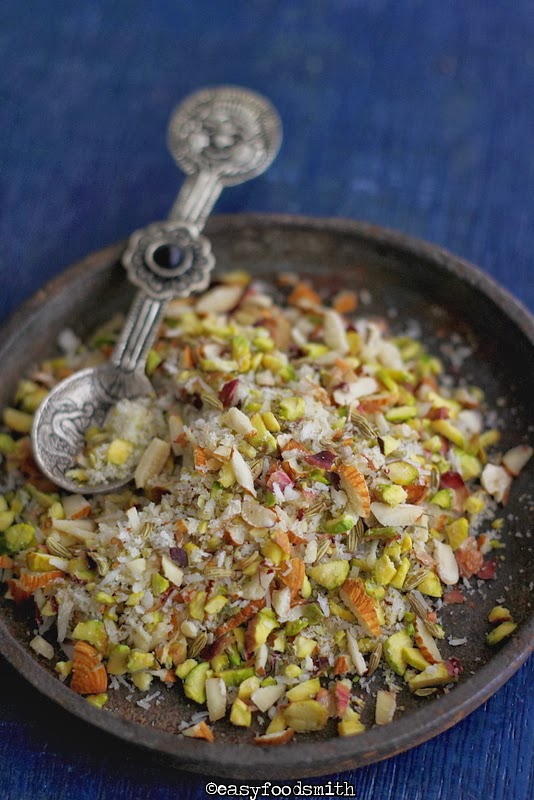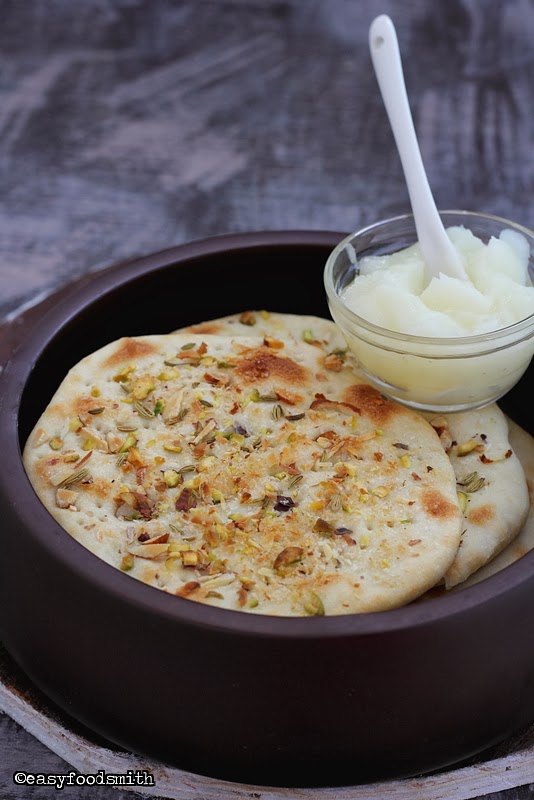India’s rich and varied cuisine is thanks to the influence & amalgamation of variety of cultures; indigenous and foreign. Similarly, Kashmiri cuisine has two distinct flavors – Wazwaan, the food of Muslims and Butta, the traditional food of the Pandits (Hindu community). Both cuisines have many dishes in common and both carry influences of Mughal style of cooking. However, Pandits abstain from using onion and garlic.
I have adapted this unique and simple recipe from the repertoire of the famous Waza brothers who have been diligently carrying forward the traditional ways of cooking the Waazwan style of food. Their father was a legendary Waza or master chef of Kashmiri cuisine and the brothers have learnt the intricacies and nuances of the Wazwaan from him. Dhaniwal korma is not a hot curry and it is usually served with rice or roti. It tastes great with Peshawari naan (Scroll down for the recipe).
For the Korma
Boil the 2½ litre water in a deep pan and add meat. Bring the water to a boil and blanch for 2-3 minutes. Remove scum from the surface of the boiling water. Drain the water and cool the meat. Keep aside.
Garnish with chopped coriander and serve hot with rice or Peshawari Naan.
Note: I added two chopped green chillies coz I wanted a little more heat in the korma.
Note: As for the amount of cooked yogurt, I prefer 3/4 (scant) cup since one whole cup made the curry too tangy for my family’s palate.
PESHAWARI NAAN
For Naan:
4 cups all purpose flour (maida)
1 tsp salt
4 tsp caster sugar
1 tsp baking soda
4 tsp yogurt (at room temperature)
4 tbsp oil or melted ghee
1 cup lukewarm milk
For filling:
2 generous tbsp almonds, finely chopped
2 generous tbsp pistachio, finely chopped
2 heaped tbsp desiccated coconut
3 tsp caster sugar
Updated on 23rd Sept 2013: I just noticed that I had mentioned 4 tsp instead of 4 tbsp of yogurt. Extremely sorry for the typo error L
Sift together the flour, salt and baking soda.
Dissolve the sugar in the milk. Beat the yogurt and add to the milk along with oil.
Add the wet ingredients to the dry one.
When the dough comes together, knead it for 7-8 minutes. Moisten your hands to knead if the dough becomes hard.
The dough should be of medium soft consistency.
Transfer the dough in a glass bowl and keep it aside for two hours.
Preheat the oven at 240 degrees C; basically the broiler (using only the top element in the oven)
Place a strong & thick bottom baking sheet in the oven and heat it.
To start making the naan, knock the dough back and divide it into 12 equal portions.
Make 12 balls of the dough and flatten them slightly.
At this point you have two options…
Either you can fill each ball with the filling and then roll it or stretch the dough on a flour dusted surface (just like pizza)
OR you can roll each ball out and sprinkle the filling over the top; pressing a little to ensure it stays on the naan.
(I prefer the latter coz it makes the naan look beautiful and there is no stress of the filling popping out of the rolled dough)
Grease the hot baking sheet with a little oil and place the rolled naans (I placed 3 at a time). Pop the sheet back in the oven a few inches away from the broiler.
Once the top of the naan starts getting blistered, turn over the naan and cook the other side.
Bake all naans in a similar way. Smear the hot naan with a little butter or ghee and serve hot with the korma.
Note: I do not use flour while rolling the dough. Instead I grease the surface with a little oil and roll the dough.
Note: Adjust the amount of filling to taste.
Serves 5-6
Thanks for visiting and see you again!
Post linked to Nancy’s YBR monthly event








As usual, I’m not only enticed by the pictures to make the dish, but I’m also very impressed with the level of detail about the background story and origin of each food you describe. 🙂
Thanks for sharing,
Miriam.
Awww..Thanks so much for your generous compliments 🙂
Interesting… the Khorma. Reducing the yoghurt is something new. And the naan. It looks simply delicious. Will give it a try even if I cannot manage that rich topping.
It was something new to me too. And it does make a difference to this korma.
This korma is so mouthwatering – any idea on how to make it vegetarian? The Naan is fantastic too.
Thanks Daniela.
You can add mushrooms, peas, asparagus or veggies of your choice. I recommend reducing the amount of cooked yogurt and adding a little cream and a teaspoon full of almond or cashew meal to give a thicker consistency and flavor to the veggie korma. I hope my suggestion suffices your query 🙂
I have a very sensitive stomach so I try to eat in moderation the hot curries. This one is very aromatic and I would love to taste it! Cardamom gives such a distinctive flavor and we, in Greece, use it in our sweets.
I too have a sensitive stomach Katerina and that is the reason this recipe sounded ideal. It is not heavy or rich. I am sure you would enjoy it.
We, Indians too use cardamoms in our sweets but we enjoy it equally in our savories too 🙂
Peshwari Naan looks just incredible and that korma is just makes me hungry, both dishes looks divine.
Thanks Priya. You sure would have enjoyed this meal 😉
wow very nice pictures….korma and naan looks so mouthwatering..
Thanks Bhawna.
That looks so delicious and very innovative dish:)
Thank you Rumana 🙂
I’ve never made naan – definitely need to some day. Fabulous korma – such great flavors. Super post – thanks.
It is really easy making naan at home. I hope you try it some day 🙂
Thanks
A 36 course meal? OMG! And very curious about this unique korma. I love it but do find it a touch sweet normally. And the naan, love love the filling.
ha ha ha…absolutely mind boggling isn’t it!?
36 course meal! Wow… I’d love to see it and taste every meal! The naan looks beautiful and delicious. Everything looks great here!
Me too!
Thanks Nami 🙂
I have always wanted to make my own naan… your naan is amazing!! Love the korma too… beautiful meal. 🙂
Thanks Ramona, and I love this version naan better than the regular one.
Wow your homemade naan looks awesome…like the lamb dish…what a great meal.
Hope you are enjoying your week 😀
Thanks Juliana.
Gorgeous styling and recipe — love all the nuts in this peshawari naan. Pinned!!
Thanks Kiran! Coming from you, it means alot to me! 🙂
Fantastic recipes, just looking at these pics makes my mouth water. Eid is just around the corner, bookmarking this to try out soon 🙂
Thanks Ambreen and I hope your family enjoys it as much as we did 🙂
wanting to make the peshawari naan and still not made. love your antique serving wares.
Thanks dear 🙂
Loved the recipe and the presentation.
First time here.Glad to follow.
Aysha
http://ashsdelicacies.blogspot.ca/
Thanks Aysha and welcome to my blog 🙂
Hoping to seeing you more often 🙂
Thks for introducing me to Wazwaan! 36 course?? Wow, I’ve only had 15 so far! Would love to sit in if I get the chance 🙂
I too haven’t tried Wazwaan and I would love to sit by your side when you do 😉
saffron, lamb, yoghurt and spices, pretty damn good for my licking for sure!
btw, isn’t is 36 courses for real???
i intrigues to see my limits…..hehehe
Thanks
Taruna I really appreciate ur efforts.This is such a solid recipe and both require some time to cook then photographing it OMG u have a lot of patience for that above all writing the indepth detail on the history of it.I am literally blown away.
For elaborate recipes, I generally pre-prep…like cooking the yogurt a day before). I made the naan along side when the korma was being cooked. So juggling helps 🙂
Also, I had pre-planned my photo composition and all I had to do was to pray that the sun would not play truant!!
Una realización perfecta se ve muy rico y saludable,abrazos.g
Thanks Rosita 🙂
This is definitely making an appearance in my next party. Looks so yummy and I am in love with the toppings for the naan, really cool. Gorgeous post. Pinning.
Thanks alot Asha 🙂 I hope your guests and family enjoy it 🙂
This look amazing. I love the vibrant color from the spices that infused into the dish. The naan looks just as wonderful too.
And wow, a 36 course meal? Wazwaan is definitely fits for the kings!
Thanks Amy.
Isn’t it amazing that there can be a 36 course meal and people can actually manage that much amount of food!!
Oh my, what a yummy dinner! I could probably eat that naan for a whole meal!
Thanks Chris.
I didn’t know about this type of korma. I love learning new things about food. It looks delicious with that lovely naan!
This korma recipe is unique to the Wazwaan cuisine perhaps the reason why you never heard of it 🙂
My favorite Indian restaurant has a curried lamb that I order all of the time. This appears to have the flavors of that dish and looks like it too. What a great dish and one I know this household would absolutely love!
Thanks a lot MJ! I hope your family would enjoy this one too 🙂
The naan looks amazing!! And the korma is pretty good looking too. Yummy, Taruna!
Looks so unique, I’ve never heard of this dish but it looks so good.
I have bookmarked it. Everything looks so ethnic, so gorgeous and so delightful. Naan and meat koram looks heavenly and your server ware too 🙂
I love Indian food because there is so much flavour and great new dishes to be discovered. This looks amazing! Thanks for being a part of the YBR:)
G’day! Your photos look so mouth-watering today!
Wish I could come and taste some of this right now!
Cheers! Joanne
Viewed as part of Your Best Recipes Sept